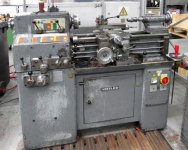Doesn't seem that anyone really answered your question to any extent, other than you can't fully evaluate a lathe that isn't under power.
I will toss out a couple things for you to check as sometimes there just isn't a way to get power, even if you take a VFD or RPC with you.
I have bought machines that didn't have power to them in the past, and in fact I have a toolroom lathe that I bought which didn't have power and it took me and a friend about 6 months (really about 4 or 5 separate weekend days in my garage) to figure out the electrical to get everything operating properly. Was wired for wrong voltage, was missing the transformer for the control circuit as the original buyer had taken it out and ran a separate power for the control circuit, leaving just a snipped off line. You need to understand that often a machine is taken out of service as it is not working correctly, that's a crap shoot to figure out if you buy one.
My suggestion if you really want the lathe, open the headstock and look at the gears and belts. See what type of condition it's in. Make sure the previous owner had oil in it, and I would try to see the gears in the apron if possible, but that might not be. Short of seeing them, make sure everything operates smoothly. You should be able to engage feeds and/or backgear and move the lathe manually (from the chuck if you need to).
I would take an oil can with you, because if it's not under power there will not be any oil pumped on the ways when you move the carriage. I would oil the ways if I was doing that to make sure I didn't do any damage that hasn't been done.
With it all oiled up on the ways, I would measure the runout with a DTI and a mount attached to the compound. Check any surfaces you can on the ways, front and back and even the flats to give you an idea of how tight everything is on the machine.
You can also test the TIR on the spindle and should get a good idea of that. You can see how the tailstock aligns with the spindle and/or if it's close or not, a live/dead center will help assist you with that. If you can put a center in the headstock end and a center in the tailstock, you can use a dti to see how close they are. Check the operation of not only the tailstock, but any other movable tooling (lever tailstocks, turrets, etc...).
You have to evaluate it for yourself and try to understand if you think the lathe is worth it or not.
In some cases if the asking price is low enough it might warrant just buying it if it seems in good shape. However, you need to understand how much it is worth for you, and it's up to you to negotiate with the seller.
From the pics the machine has been used. Some people ask to evaluate a lathe or ask how much it's worth from a picture, at least you didn't do that...

Although the machine has been used, that is not a bad thing in itself. You really need to know if it's been taken care of properly. If it has, the ways and spindle could be just fine. If not they could be your worst nightmare if you want to fix it properly. As they say in the used machinery market, caveat emptor!

Lastly, if you do buy it, make sure you get all the tooling that goes with it, and ask more than once if there is anything more that went with the lathe.











 (from throwing the chuck through his window), you'd have to be pretty close to throw it through his window since most chucks aren't light.
(from throwing the chuck through his window), you'd have to be pretty close to throw it through his window since most chucks aren't light.